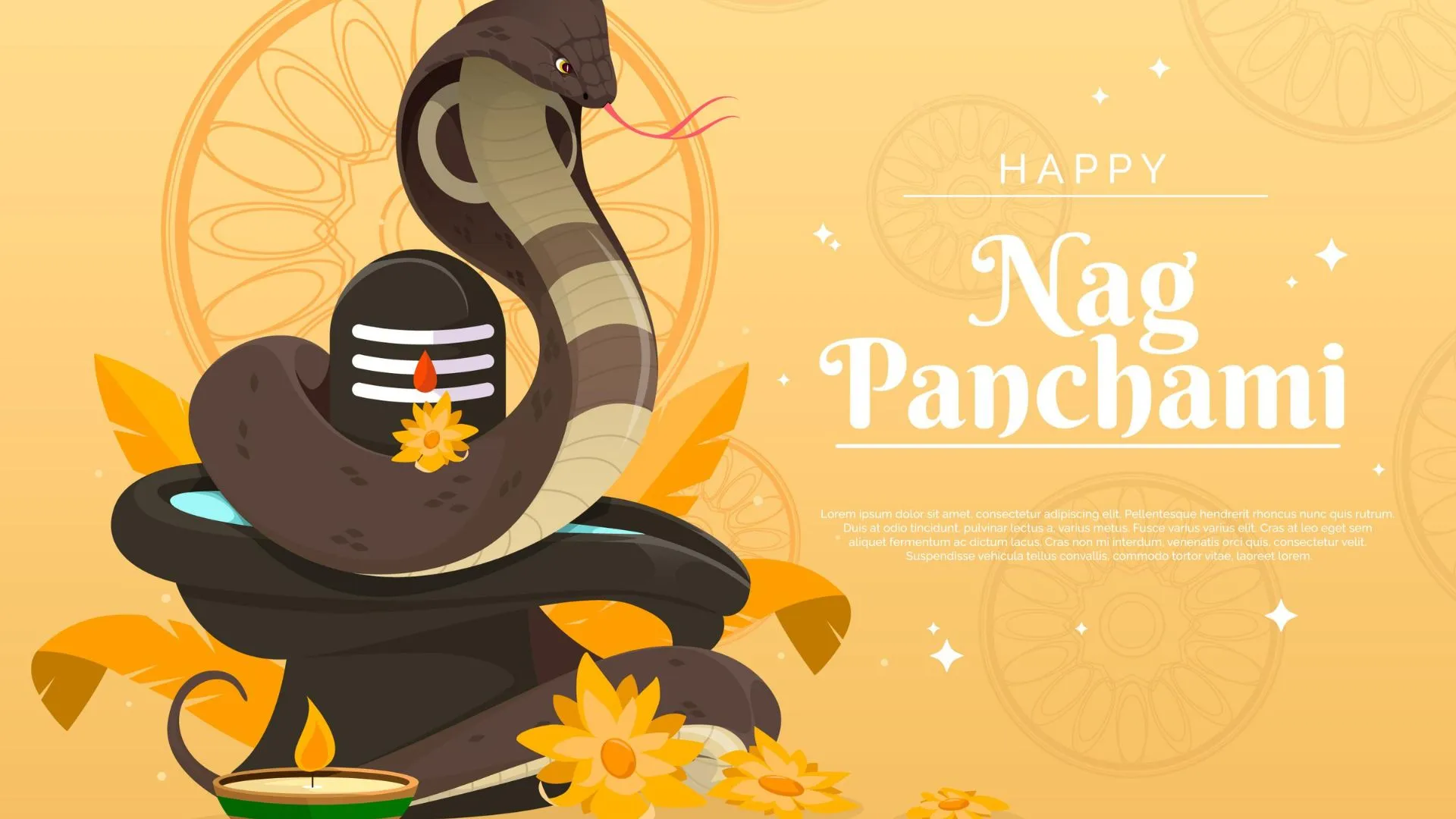Nag Panchami is a sacred Hindu festival dedicated to the worship of serpent deities, primarily Nag Devtas (snake gods). Celebrated on the fifth day of the Shukla Paksha (waxing moon phase) in the month of Shravan, this festival holds deep spiritual and cultural significance, especially in India and Nepal. It is believed that worshipping Nagas on this day removes the ill effects of Kaal Sarp Dosh in one’s horoscope.

Table of Contents
Nag Panchami
Nag Panchami will be observed on Tuesday, 29th July 2025. On this auspicious day, devotees offer milk, turmeric, rice, and flowers to live snakes or idols of Nag Devtas. Temples dedicated to snakes, like those in South India and Maharashtra, witness large gatherings of devotees performing traditional rituals.
When is Nag Panchami 2025?
Panchami Tithi Timing:
- Begins: 11:24 PM on July 28, 2025
- Ends: 12:46 AM on July 30, 2025
- Mainly celebrated on Tuesday, July 29, 2025.
Nag Panchami Puja Muhurat:
- 05:41 AM to 08:23 AM (Duration: 2 Hours 43 Minutes)
Nag Panchami Date in Gujarat: Wednesday, August 13, 2025
Note: The timings may slightly vary depending on the geographical location. Always refer to a reliable Panchang.
Read also: Religious Significance of Nag Panchami: Why Are Snake Deities Worshipped on This Day?
What is the Significance of Nag Panchami?
Nag Panchami holds a vital place in the Hindu spiritual calendar. The term “Nag” means serpent or snake, and “Panchami” refers to the fifth day of the lunar fortnight. Hindus believe that snakes possess divine qualities and are closely associated with several deities including Lord Shiva (who wears a snake around his neck), Lord Vishnu (resting on the serpent Sheshnag), and Lord Subramanya (worshipped as the serpent god in South India).
According to ancient texts, observing Nag Panchami brings blessings and mitigates the negative effects of Kaal Sarp Dosh in astrology. It is also seen as a day to respect all creatures in the ecological cycle, especially those that live in hidden and dangerous places like snakes.
In rural parts of India, the festival is observed with devotion, and even live cobras are venerated and fed milk (under the supervision of snake charmers).
Rituals and Traditions Followed on Nag Panchami
Nag Panchami rituals vary across regions, but certain traditions remain common:
1. Early Morning Bath and Prayer: Devotees begin their day with a holy bath ans Lord Shiva is worshipped.
2. Drawing Snake Images: In many states like Maharashtra, Gujarat, and Bengal, snake figures are drawn on the walls or the floor using cow dung or turmeric paste and are worshipped with vermilion and flowers.
3. Offering Milk and Sweets: People offer milk, jaggery, ghee, rice pudding, and sweets to snake idols or real snakes (with caution and devotion).
4. Visiting Snake Temples: Famous temples like the Mannarasala Temple in Kerala and Nagoba Temple in Maharashtra see a huge footfall on this day.
5. Traditional Songs and Folk Dances: Women sing traditional Nag Panchami songs and perform folk dances to honor the serpent gods.
6. Kaal Sarp Dosh Nivaran Pujas: Special remedies and pujas are conducted in temples or by priests for those suffering from astrological defects related to serpents.
Do’s and Don’ts on Nag Panchami
Do’s:
- Wake up early, bathe, and offer prayers to Nag Devta and Lord Shiva.
- Visit temples dedicated to serpents and perform puja.
- Offer milk, turmeric, flowers, and sweets with devotion.
- Chant specific mantras for protection from negativity and Kaal Sarp Dosh.
Don’ts:
- Avoid digging the earth or ploughing fields as it might harm snakes residing underground.
- Do not harm or kill snakes on this day.
- Avoid consuming salty food or non-vegetarian meals.
- Do not insult any form of divine energy symbolized by the serpent.
Powerful Mantras and Prayers for Nag Panchami
Chanting mantras dedicated to serpent deities on Nag Panchami brings divine protection and peace.
1. Sarpa Shanti Mantra: नित्यम हर परायण अपहृत्य विषम घोरम करोतु मम शांतिकम अंतरिक्ष ये नागा ये नागा स्वर्ग संस्थिति गिरी कंदर दुर्गेशु ये नागा भूमि।
2. Nag Gayatri Mantra: ॐ नवकुलाय विद्यमहे विषदंताय धीमहि तन्नो सर्प: प्रचोदयात् ।।
3. ॐ व्याल नम:
4. ॐ अहि नम:
5. ॐ विषधर नम:
6. ॐ शैल नम:
These mantras should be chanted with sincerity and focus, ideally during early morning hours or during the puja muhurat.
Regional Celebrations and Temple Observances
- South India: In states like Karnataka and Kerala, Nag Panchami is celebrated with grandeur. Women offer prayers at anthills and temples like the Subramanya Temple.
- Maharashtra: Drawing live snake images outside the house and offering milk is a major tradition.
- Uttar Pradesh and Bihar: Special folk traditions are observed where women sing songs and narrate the legend of Nag Devta.
- Nepal: The festival is celebrated with rituals in the Pashupatinath temple and homes where serpent icons are drawn and revered.
Popular temples to visit:
- Mannarasala Temple, Kerala
- Nagoba Temple, Maharashtra
- Subramanya Temple, Karnataka

